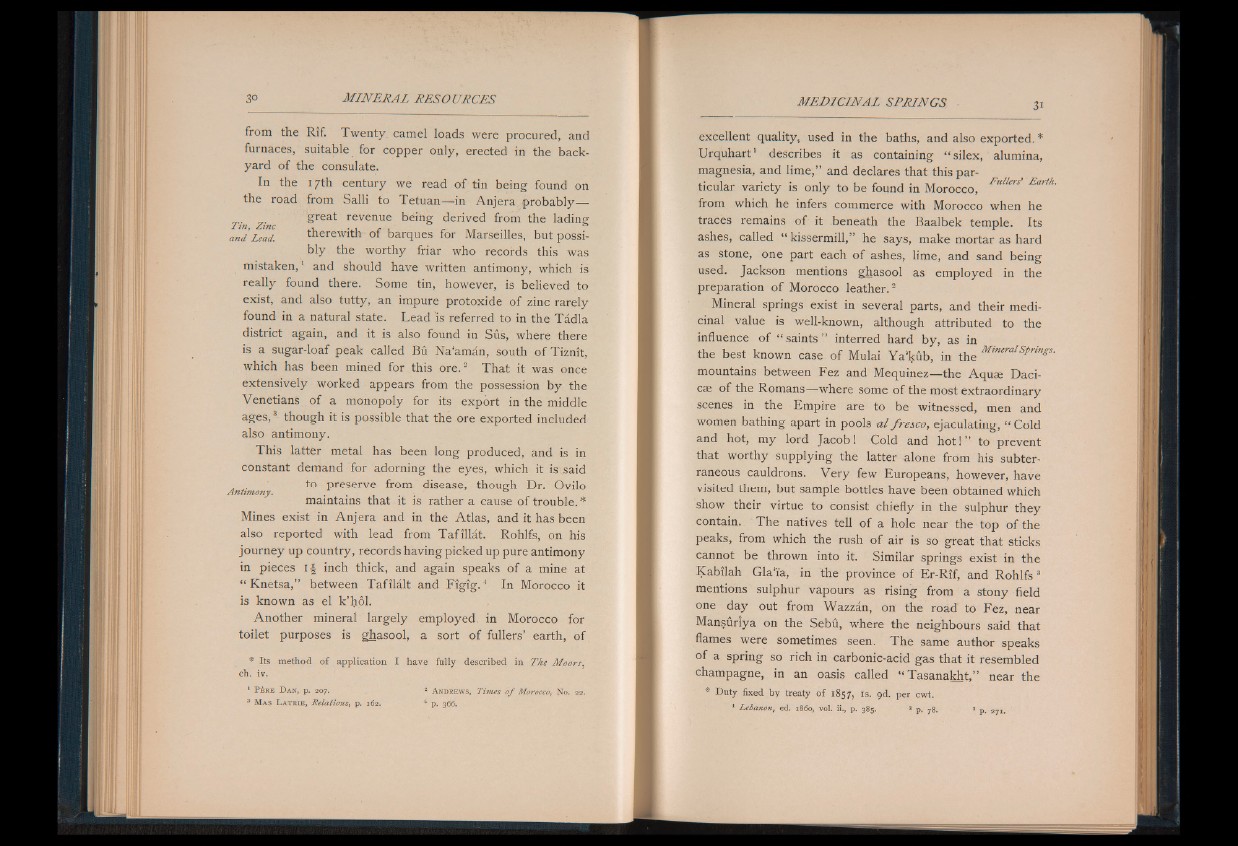
from the Rîf. Twenty camel loads were procured, and
furnaces, suitable for copper only, erected in the backyard
of the consulate.
In the 17th century we read of tin being found on
the road from Salli to Tetuan— in Anjera probably—
great revenue being derived from the lading
T m , Zm c • 1 r 1 *
and Lead. therewith of barques for Marseilles, but possi-
bly the worthy friar who records this was
mistaken,1 and should have written antimony, which is
really found there. Some tin, however, is believed to
exist, and also tutty, an impure protoxide of zinc rarely
found in a natural state. Lead is referred to in the Tadla
district again, and it is also found in Sûs, where there
is a sugar-loaf peak called Bû Na’aman, south ofTiznit,
which has been mined for this ore.2 That it was once
extensively worked appears from the possession by the
Venetians of a monopoly for its export in the middle
ages,3 though it is possible that the ore exported included
also antimony.
This latter metal has been long produced, and is in
constant demand for adorning the eyes, which it is said
„ . to preserve from disease, though Dr. Ovilo Antimony. . °
maintains that it is rather a cause o f trouble. *
Mines exist in Anjera and in the Atlas, and it has been
also reported with lead from Tafîllât. Rohlfs, on his
journey up country, records having picked up pure antimony
in pieces I ■§ inch thick, and again speaks o f a mine at
“ Knetsa,” between Tafîlâlt and F îg îg .4 In Morocco it
is known as el k ’hôl.
Another mineral largely employed, in Morocco for
toilet purposes is ghasool, a sort of fullers’ earth, of,
* Its method of application I have fully described in The Moors
ch. iv.
1 P è r e D a n , p. 207. 2 A n d r e w s , Times o f Morocco, N o . 22.
3 M a s L a t r i e , Relations, p. 162. 4 p , 366.
excellent quality, used in the baths, and also exported. *
Urquhart1 describes it as containing “ silex, alumina,
magnesia, and lime,” and declares that this particular
variety is only to be found in Morocco, Fullers Eart,u
from which he infers commerce with Morocco when he
traces remains of it beneath the Baalbek temple. Its
ashes, called “ kissermill,” he says, make mortar as hard
as stone, one part each of ashes, lime, and sand being
used. Jackson mentions ghasool as employed in the
preparation o f Morocco leather.2
Mineral springs exist in several parts, and their medicinal
value is well-known, although attributed to the
influence o f “ saints” interred hard by, as in
the best known case of Mulai Y a ’kub, in the MincralsU inzs-
mountains between Fez and Mequinez— the Aquae Daci-
cae of the Romans— where some of the most extraordinary
scenes in the Empire are to be witnessed, men and
women bathing apart in pools a l fresco, ejaculating, “ Cold
and hot, my lord Jacobi Cold and h o t ! ” to prevent
that worthy supplying the latter alone from his subterraneous
cauldrons. Very few Europeans, however, have
visited them, but sample bottles have been obtained which
show their virtue to consist chiefly in the sulphur they
contain. The natives tell o f a hole near the top of the
peaks, from which the rush o f air is so great that sticks
cannot be thrown into it. Similar springs exist in the
Kabilah Gla’i'a, in the province of Er-Rif, and Rohlfs 3
mentions sulphur vapours as rising from a stony field
one day out from Wazzan, on the road to Fez, near
Mansuriya on the Sebu, where the neighbours said that
flames were sometimes seen. The same author speaks
of a spring so rich in carbonic-acid gas that it resembled
champagne, in an oasis called “ Tasanakht,” near the
* Duty fixed by treaty of 1857, is. 9d. per cwt-.
1 Lebanon, ed. i860, vol. ii., p. 385. 2 p. 78. 8 p. 271.